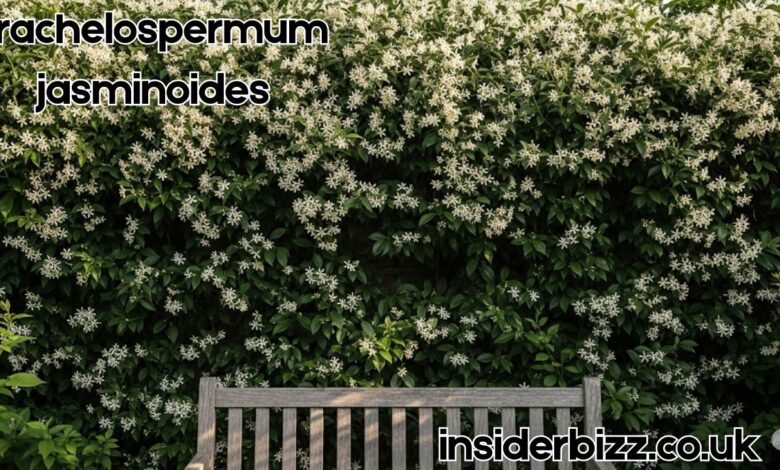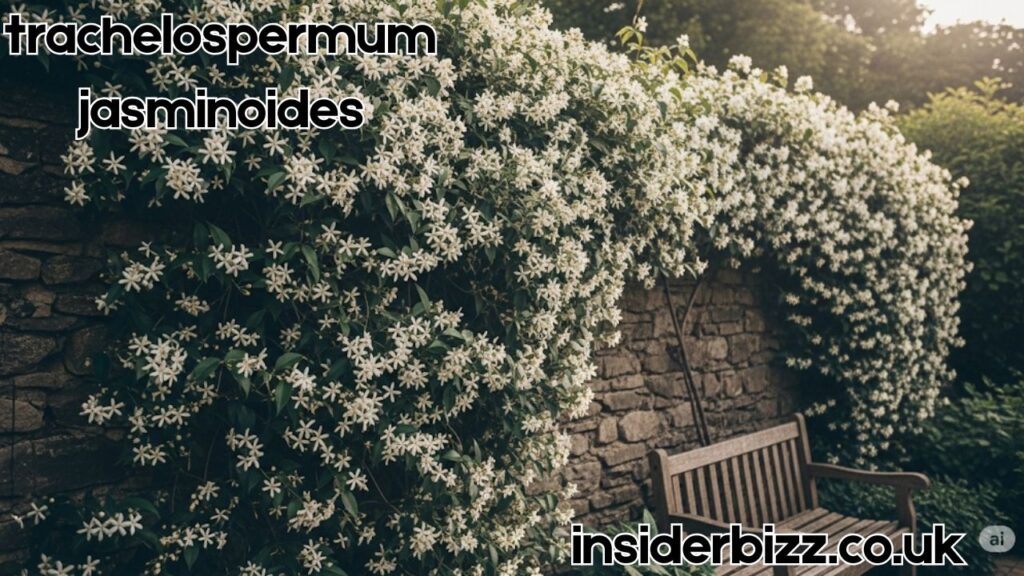
Trachelospermum Jasminoides: The Fragrant Star of Garden Walls
Introduction to Trachelospermum Jasminoides
Trachelospermum jasminoides, commonly known as star jasmine or confederate jasmine, is a beloved evergreen climber celebrated for its fragrant white blossoms and glossy foliage. Originating from East and Southeast Asia, this plant has gained immense popularity in ornamental horticulture due to its ability to cover walls, trellises, and pergolas with lush beauty and a sweet aroma that fills the summer air.
Despite its name, trachelospermum jasminoides is not a true jasmine but shares many of its best qualities. Its long blooming period, drought tolerance once established, and manageable growth pattern make it a favorite in gardens around the world, especially in Mediterranean-style landscapes.
Botanical Features of Trachelospermum Jasminoides

Trachelospermum jasminoides features leathery, dark green leaves that remain attractive year-round. The plant’s twining stems readily cling to supports, making it ideal for vertical surfaces. When in bloom, trachelospermum jasminoides produces small, pinwheel-shaped white flowers with a heavenly scent that intensifies in the evening.
The flowers bloom from late spring into early autumn, forming clusters that attract pollinators and garden admirers alike. Over time, the stems become woody, lending structure and permanence to its growth. The visual and olfactory experience created by trachelospermum jasminoides is unmatched among evergreen vines.
Cultivating Trachelospermum Jasminoides in Various Climates
Trachelospermum jasminoides thrives in full sun to partial shade and prefers well-draining soil. It is hardy in USDA zones 8 to 10, tolerating both heat and light frost. In cooler regions, it can be grown in containers and overwintered indoors.
The plant responds well to consistent watering during its establishment phase, after which it becomes more drought-resistant. Its ability to flourish in urban environments makes trachelospermum jasminoides a smart choice for balconies, patios, and small garden spaces where vertical planting is key.
Designing Gardens with Trachelospermum Jasminoides
Trachelospermum jasminoides is a versatile design element in both formal and informal gardens. It can be trained along trellises, fences, arches, and pergolas to create green architecture that softens hardscapes and adds vertical interest. When used as ground cover, trachelospermum jasminoides forms a dense carpet that suppresses weeds and stabilizes slopes.
Its fragrant blooms make it especially desirable near seating areas, windows, and entrances. Gardeners often plant trachelospermum jasminoides where its scent can be enjoyed at leisure. Whether used to frame an entryway or provide a living privacy screen, this plant adds romantic flair to any setting.
Seasonal Performance and Year-Round Appeal
One of the key strengths of trachelospermum jasminoides is its seasonal consistency. While many climbers lose their leaves or die back in winter, trachelospermum jasminoides remains evergreen in mild climates. Its dense foliage provides structure, screening, and color even when other plants are dormant.
In spring and summer, its prolific blooming adds bursts of white against green foliage, creating dramatic contrasts that evolve with the changing light. Even when not in bloom, trachelospermum jasminoides maintains its elegant appearance, earning it a permanent place in garden design.
Ecological Contributions of Trachelospermum Jasminoides
Beyond its beauty and scent, trachelospermum jasminoides plays a role in supporting garden ecosystems. The flowers are a valuable nectar source for bees and butterflies, helping maintain local pollinator populations. Its dense foliage also offers shelter to small birds and beneficial insects.
Because it’s not invasive in most regions and requires relatively low inputs, trachelospermum jasminoides supports sustainable gardening practices. It aligns well with the goals of low-impact, water-conscious garden design and is often included in wildlife-friendly plans.
Propagation and Maintenance Guidelines
Trachelospermum jasminoides can be propagated from semi-hardwood cuttings taken in late summer. These cuttings root easily under the right conditions and produce vigorous young plants. Once established, trachelospermum jasminoides needs minimal care beyond annual pruning.
Pruning after flowering helps maintain shape and encourages bushier growth. Removing old or damaged stems keeps the plant healthy and attractive. Feeding with a balanced fertilizer in spring supports lush flowering. In colder zones, container-grown specimens benefit from indoor protection during winter.
Popular Cultivars and Variations

While trachelospermum jasminoides is most commonly seen in its classic white-flowered form, there are several cultivars that offer unique traits. Some feature variegated leaves with cream or gold margins, adding extra ornamental value even when not in bloom.
These variations allow gardeners to tailor the plant to their specific aesthetic goals. Whether aiming for subtle elegance or bold contrasts, trachelospermum jasminoides delivers adaptable options. In all forms, its signature fragrance and foliage remain key attractions.
Pairing Trachelospermum Jasminoides with Companion Plants
Trachelospermum jasminoides works harmoniously alongside many other garden plants. Its glossy leaves contrast beautifully with the fine textures of ornamental grasses or ferns. Underplanting it with lavender, salvia, or rosemary creates layered planting beds rich in color and scent.
In larger garden designs, trachelospermum jasminoides complements Mediterranean species like olive trees, agapanthus, and cistus. In formal settings, it balances structured hedges or topiary with its free-flowing nature. Wherever it is planted, trachelospermum jasminoides enhances and supports the surrounding landscape.
Cultural Significance and Long-Term Value
The enduring popularity of trachelospermum jasminoides lies not just in its appearance, but in the atmosphere it creates. It evokes warm evenings, outdoor living, and quiet relaxation. Many gardeners form lasting attachments to the plant due to its evocative scent and presence.
Over time, trachelospermum jasminoides becomes a permanent fixture in the landscape, forming strong woody stems and expansive coverage. It matures into an architectural element, offering shade, fragrance, and visual beauty for decades with proper care.
Also Read : Exploring the Power of Prostavive Colibrim for Prostate Wellness



